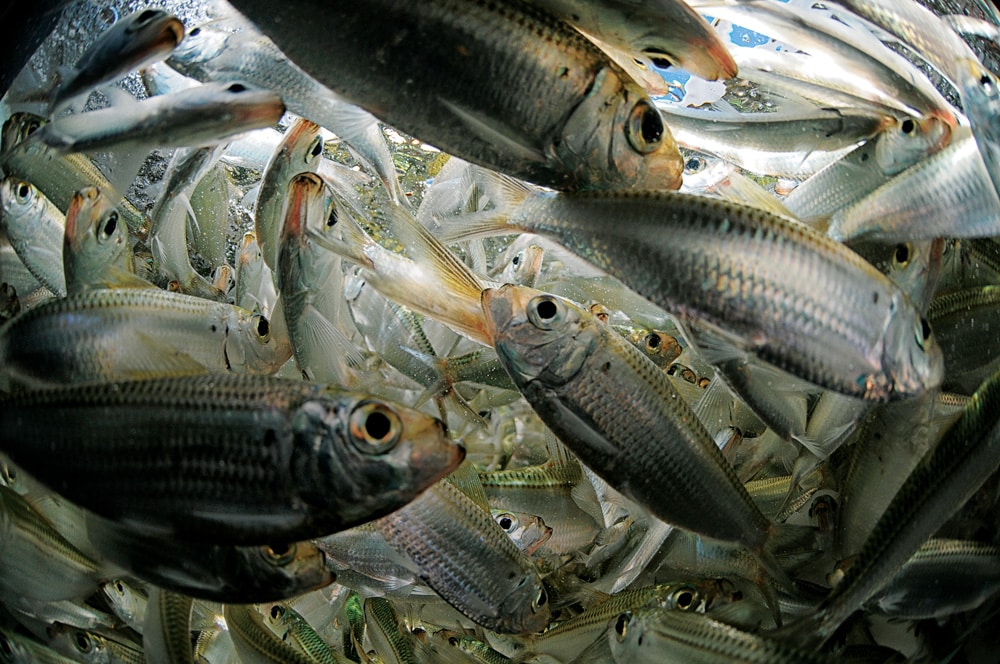
Face the facts: Most days, a frisky live bait outperforms an artificial or dead bait, whether you’re targeting snook in Charlotte Harbor, sailfish off the Keys, striped bass in Long Island Sound or yellowfin tuna off California.
That’s why today’s top saltwater-fishing boats feature circulating livewell systems. Without one, you’re at a serious disadvantage. Yet’s there’s much more to the fine art of keeping bait alive and kicking than just having a livewell (or live bait tank, as they are known on the West Coast). In these onboard life-support systems, details count big-time, particularly for delicate live baits such as anchovies, pilchards and sardines.
Fishing with live bait was pioneered on the West Coast beginning in the 1940s. Today, boats fishing the waters off Southern California and Baja are often characterized as “motorized livewells,” and anglers adhere to the belief that you can never have enough love, money or live bait. But anglers on the East Coast and the Gulf of Mexico also have contributed mightily to the school of live-bait fishing, especially over the past four decades, and are now teaching the Left Coast a few tricks. Let’s look at 15 of the most important factors gleaned from coast to coast about keeping captive live bait as lively as possible.
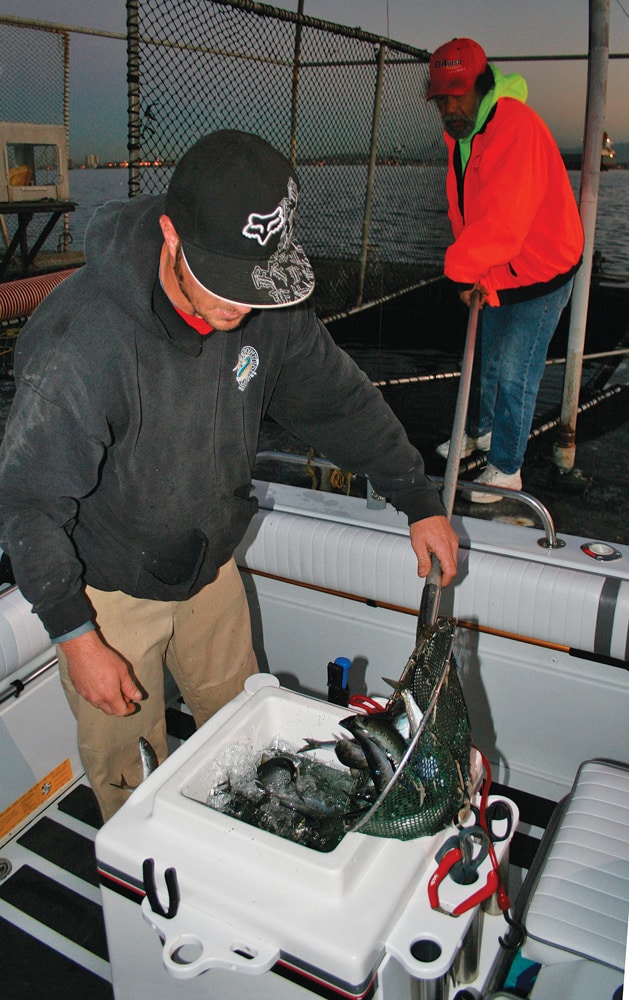
1. Tank Geometry
Put yourself in the fins of a pilchard. Before finding yourself aboard Live Bait Express, you’ve scarcely touched anything more solid than a blade of turtle grass. Now you’ve been dumped in a livewell and discover a ring of walls that can bruise, batter and bloody your nose.
You can help Mr. Pilchard from getting banged up by choosing a livewell that’s taller than it is wide. The idea is to create something akin to a column shape versus a bathtub shape, achieving two major goals. First, when the tank is full of water, it minimizes sloshing that can slam live bait against the sides of the well. This is especially critical for boats that fish offshore and often run in rough water.
Second, a column shape promotes “milling” — the tendency of the bait to swim in a relaxed circle. There’s a popular perception that round or oval wells are better than tanks with square corners, but all factors being equal, a square tank will hold bait just as well as a round or oval shape, according to Mark Wisch, owner of Pacific Edge Bait Tanks in Huntington Beach, California. “Our original PE-28S 28-gallon bait tank has a square footprint, and it holds bait exceedingly well,” Wisch reveals.
2. Minimal Obstructions
Choose a tank that has as few obstructions inside as possible. One of the most common obstructions inside older livewells is an exposed standpipe, usually in the middle of the tank. Water fills the tank until it reaches the top of the pipe, then it exits through the screened top. While it works for maintaining the water level, it does not always work well for maintaining live bait — it’s just something foreign for Mr. Pilchard to bang against.
Newer livewells have the standpipe inside a baffle within the wall of the tank, eliminating the obstruction. But look for other obstructions such as screws used to secure rod holders on the outside of the live well. Make sure the inside walls are as smooth as possible.
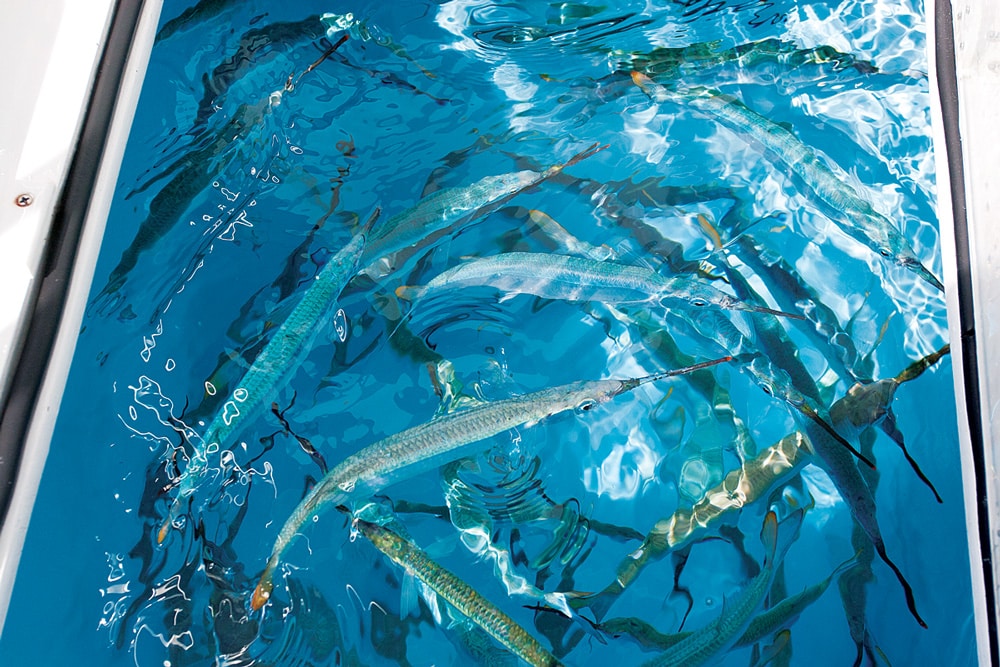
3. Water Flow
West Coast fishermen learned long ago that there are two secrets to good water flow in a bait tank. One is to regulate the water flow with a valve on the downstream side of the livewell pump. “You don’t want too much water flow, as that creates turbulence that tires the bait and knocks scales loose,” Wisch explains. “You need just enough to flush impurities from the tank.” Wisch offers some rules of thumb: For livewells ranging from 20 to 32 gallons, a fill time of six to eight minutes is best, while tanks ranging 33 to 50 gallons should fill in eight to 12 minutes.
The second factor focuses on how the water enters the livewell. “It should trickle in from the upper portion of the tank,” says Wisch. “Bringing it in from the bottom blows scales throughout the tank, and that’s not good for the bait.”
The idea that water should enter in a cyclonic manner to create a swirling current is also off-base, according to Wisch. “You want the water to be tranquil yet fresh,” he explains. “Any current inside the tank just stresses the bait.”
4. Tank Location
If you’re adding a livewell from a company such as Aquaworld or Kodiak Marine, choose the smoothest-riding area of the boat to install it, as Mr. Pilchard doesn’t care much for getting jostled around while you’re running to the fish. The best spots are usually near the transom, in the aft cockpit or under the leaning post. Resist the temptation to install your primary livewell in the bow area, as this section tends to bounce the most while under way. You might choose the bow area to install a second livewell, but reserve this tank for hardier bait such as goggle-eyes, mackerel and pinfish.
5. Plenty of Power
Make sure you have the battery capacity to run the bait pump(s) all day and then some without recharging, as the last thing you want to do is deprive Mr. Pilchard a fresh supply of life-sustaining water. Dedicate the largest marine deep-cycle battery or battery bank you can fit in your boat to running the bait pump(s), and make sure you leave the dock with a full charge. Also, connect the bait-battery system to the engine charging system with a device such as a automatic charging relay so it can get juice on the fly.

6. Loading and Handling
A credo of the computer industry — junk in, junk out — also applies to live bait, whether you’re cast-netting, jigging it up with a Sabiki rig or transferring it from a live-bait receiver. Once again, dress yourself in the scales of Mr. Pilchard and realize that he has never come in contact with anything hard in his life. With this in mind, the No. 1 rule in loading bait is: Don’t let bait fall on the deck. For Mr. Pilchard, dropping three feet to the deck is tantamount to your jumping off a two-story building. Even if you survive the fall, you’re going to be hurting.
This means after you throw a cast net, lower the loaded net directly into the livewell before shaking out the ballyhoo, mullet or pilchards. If that proves impractical, dip the net into a five-gallon bucket of water before shaking it out, and then gently pour the bait into the well as quickly as possible.
If you’re jigging bait, use a stainless-steel bait dehooker to shake the bait off the hook over the well, allowing it to drop directly into the water. Avoid grabbing the bait with your hands, as this can damage the scales and protective slime coat — injuries that weaken and eventually kill the bait.
On the West Coast, boating anglers often purchase live bait such as sardines from floating bait barges. Transferring the bait with long-handled nets known as brails to maximize survival is an art form perfected by bait operators that supply the San Diego long-range boats. The most conscientious operators transfer just five to 10 “pieces” (as Californians refer to individual baitfish) at a time, thus eliminating the crushing effect of a loaded net. If you find an operator who’s not following this practice, politely ask him to lighten each pass (and tip him for his cooperation), which might result in healthier bait for a day of fishing.
7. Cured Bait
Curing refers to the practice of holding bait in captivity for a few days, allowing the weak individuals to fall by the wayside, leaving only the most resilient baits. It might seem counterintuitive, but cured bait survives longer in the livewell than freshly caught bait.
West Coast bait operators were the first to discover this, and knowledgeable boating anglers tend to gravitate toward the barges that sell cured bait. Today, savvy anglers coast to coast who keep their boats in the water often cure their own by catching baits ahead of time, and leaving them in running bait tanks or in floating pens, and feeding them until it’s time to go fishing.
However, curing is not always possible, particularly if the water at the marina is too warm or of poor water quality. In these cases, the bait just won’t survive. Also, delicate species such as pilchards don’t always to lend themselves to curing.

8. Population Control
There’s a tendency to load the livewell with as much bait as possible, but this can be counterproductive, as overcrowding leads to increased mortality. With experience, you’ll be able to just look in the tank and determine by the bait density when it has reached maximum capacity. Yet if you’re having a hard time gauging how much is enough, try this trick employed by San Diego long-range boats. Tap on the bottom of the livewell with a gaff handle; the bait will scatter outward, creating an open vertical space in the center of the tank. Keep taking bait until the open space in the center no longer appears when you tap on the bottom.
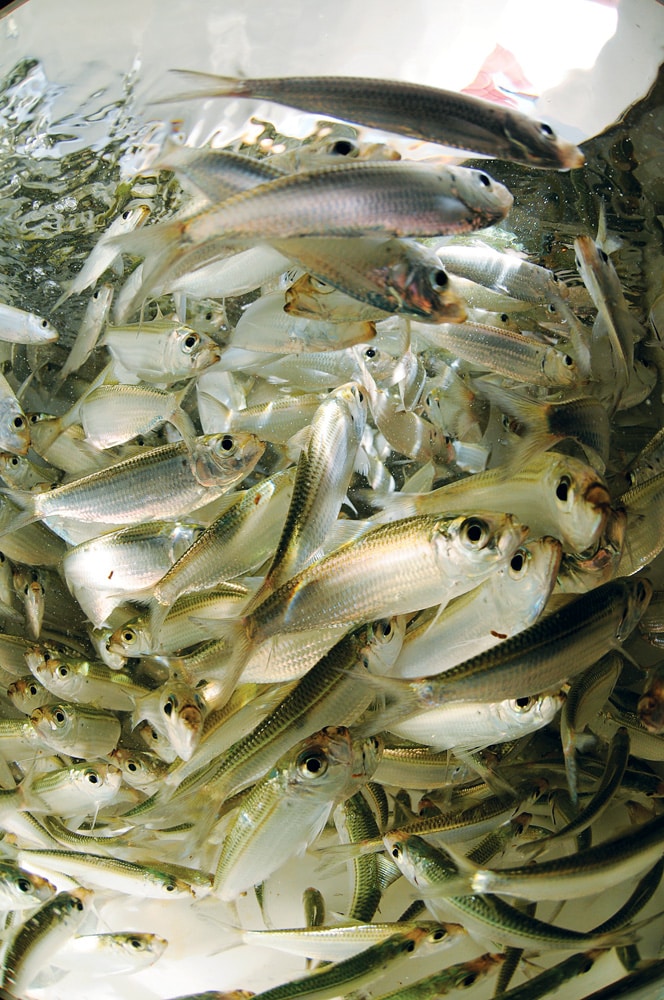
9. Culling the Dead
It’s important to pluck any dead baits from the livewell as soon as possible after they croak, as these decomposing bodies secret impurities, such as ammonia, that contaminate the water. From Mr. Pilchard’s point of view, that’s pretty gross, not to mention dangerous to his health. However, if the dead baits are at the bottom of the tank, be careful not to strike or accidently scoop up any live baits with the dip net. If the tank is not too deep, remove the dead baits by hand.
10. Careful Dipping
Speaking of the dip net, when it comes time to dip out a live bait, avoid the tendency to scoop up a mess of wriggling bait fish, unless you’re going to chum with them. When looking for a hook bait, carefully dip one bait at a time. This keeps the rest of the live ones healthy and panic-free. Instruct your crew to do the same, as two or three anglers continually scooping netfuls of bait will rapidly destroy the vitality of your bait supply.
11. Smooth the Ride
Few factors can knock the life out of Mr. Pilchard faster than a rough ride in snotty seas. If a supply of lively bait ranks as a high priority, think about ways to smooth the ride of your boat. Frequently, this is just a matter of slowing down when seas build, though some high-powered fishing boats designed for the kingfish tournament circuit actually ride more smoothly as speed increases.
12. Seal the Tank
One of the tricks that East Coast and Gulf Coast boatbuilders have taught us is the idea of sealing the livewell to keep water from sloshing out while under way. This not only keeps the deck dry, but it also keeps the maximum amount water in the tank — the more water you have, the happier Mr. Pilchard becomes. To seal the livewell, builders use a compression latch on a clear acrylic hatch that is seated on a gasket. The clear hatch allows you to check the bait without opening the top.
13. Easy-Access Opening
Some built-in livewells have openings that are too small or too difficult to access. That creates issues for both loading and retrieving baits. Better boatbuilders recognize this and design livewell openings for unfettered access.
“We make the openings to livewells as large as possible,” says Les Stewart Jr., director of marketing for Contender Boats. “This makes it easy to drop a cast net inside or to pour a five-gallon bucket of bait and water into the tank. In addition, a large opening offers quick access to the live bait when fishing.”
14. Slammer Tank
Another way to increase bait capacity is to add a second livewell by plumbing an insole locker, usually one in the cockpit. These below-deck livewells are known as slammers on the West Coast. It’s important that the hatch is gasketed and has a compression latch to keep the water and bait from bubbling up on to the deck in rough seas. Also, from a safety point of view, it’s best not to fish from this tank, but rather use it only to replenish the main livewell, as leaving it open in the midst of the action could lead to a busted ankle.
15. Light It Up
There are some anglers who argue that a light inside a livewell is pointless, since bait fish swim in the dark every night. Yes, but they don’t swim in an environment with walls around it. So I contend that every livewell should have a light if you intend to carry bait in the dark or if you put an opaque lid on the tank during the day.
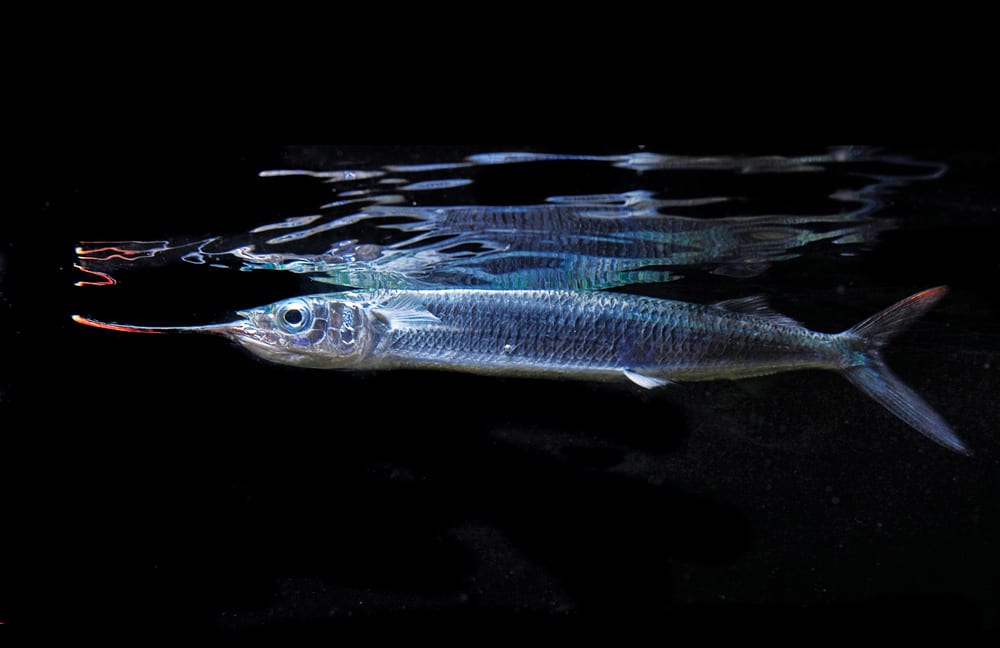
Signs of Bad Bait
A number of signs indicate weak or struggling bait.
Scale Loss: If you see a lot of loose scales floating amid the live bait, it’s a sure sign your bait might not be healthy and will be short‑lived.
Dry Skin: Pick up one of the baits and feel it. Healthy baitfish sport a nice coat of slime, but if the skin feels dry and raspy, the bait esta no bueno.
Red Noses: Chafed, blood-red noses is an indication that the bait has been beat up, either in a net through improper handling or due to improper water flow in the livewell. Red-nosed bait might last a while, but it’s not as desirable as bait with natural-looking snouts.
Failure to Mill: Healthy bait should settle down and exhibit a relaxed milling behavior soon after you put them in the livewell. If they dart about or swim with their noses against the sides of the tank, it’s usually a sign of too much water flow. Try turning it down a bit to see if they will begin milling. If not, fish quickly, because your bait is not long for this world.








